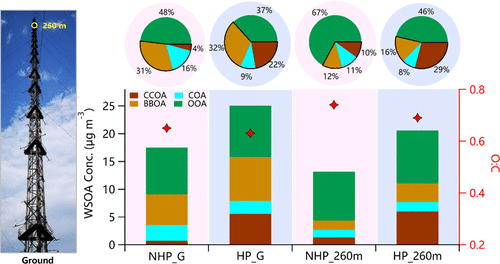当前位置:
X-MOL 学术
›
ACS Earth Space Chem.
›
论文详情
Our official English website, www.x-mol.net, welcomes your feedback! (Note: you will need to create a separate account there.)
Vertical Characterization and Source Apportionment of Water-Soluble Organic Aerosol with High-resolution Aerosol Mass Spectrometry in Beijing, China
ACS Earth and Space Chemistry ( IF 3.4 ) Pub Date : 2019-01-17 00:00:00 , DOI: 10.1021/acsearthspacechem.8b00155 Yanmei Qiu 1, 2 , Qiaorong Xie 1, 2 , Junfeng Wang 3 , Weiqi Xu 1, 2 , Linjie Li 1, 2 , Qingqing Wang 1 , Jian Zhao 1, 2 , Yuntao Chen 3 , Yanfang Chen 3 , Yangzhou Wu 3 , Wei Du 1, 2 , Wei Zhou 1, 2 , James Lee 4 , Chuanfeng Zhao 5 , Xinlei Ge 3 , Pingqing Fu 1, 2 , Zifa Wang 1, 2 , Douglas R. Worsnop 6 , Yele Sun 1, 2, 7
ACS Earth and Space Chemistry ( IF 3.4 ) Pub Date : 2019-01-17 00:00:00 , DOI: 10.1021/acsearthspacechem.8b00155 Yanmei Qiu 1, 2 , Qiaorong Xie 1, 2 , Junfeng Wang 3 , Weiqi Xu 1, 2 , Linjie Li 1, 2 , Qingqing Wang 1 , Jian Zhao 1, 2 , Yuntao Chen 3 , Yanfang Chen 3 , Yangzhou Wu 3 , Wei Du 1, 2 , Wei Zhou 1, 2 , James Lee 4 , Chuanfeng Zhao 5 , Xinlei Ge 3 , Pingqing Fu 1, 2 , Zifa Wang 1, 2 , Douglas R. Worsnop 6 , Yele Sun 1, 2, 7
Affiliation

|
Water-soluble organic aerosol (WSOA) constitutes a large fraction of organic aerosol (OA) and plays an important role in affecting aerosol hygroscopicity and cloud condensation nuclei formation. Here, we characterized WSOA in fine particles that were collected at ground level and at 260 m on a meteorological tower in Beijing in winter using offline aerosol mass spectrometry (AMS) and compared them with the simultaneous real-time online AMS measurements. Our results showed large increases in WSOA from nonheating season to heating season by 43% and 53% at ground level and at 260 m, respectively. WSOA was highly oxidized in winter with a higher oxygen-to-carbon ratio (O/C = 0.69) at 260 m than at ground level (0.63). On average, WSOA contributed 47% and 52% to the total OA at ground level and at 260 m, respectively. Positive matrix factorization analysis further showed that primary OA was the dominant source of WSOA (52–61%) with coal combustion (CCOA) and biomass burning OA (BBOA) being two major contributors. The vertical differences in water-soluble CCOA and BBOA, however, were very different with ubiquitously higher CCOA at 260 m than at ground level. Comparatively, more than 50% of secondary OA in winter was found to be water-insoluble, highlighting the influences of fossil emissions. The observed high water-solubilities of CCOA (42–53%) and BBOA (61–78%) may have significant implications in severe haze formation in winter in Beijing through a positive feedback mechanism between substantial increases in primary emissions during heating season and the subsequent changes in aerosol liquid water content, radiative forcing, and boundary layer, which is not yet considered in chemical-transport models.
更新日期:2019-01-17


























 京公网安备 11010802027423号
京公网安备 11010802027423号